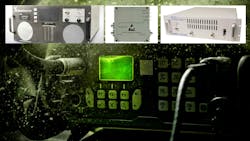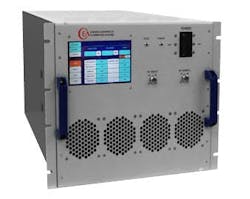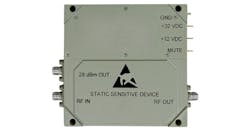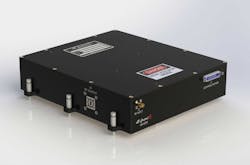Power Amplifiers Fuel Mil/Aero Ground and Space Systems
Members can download this article in PDF format.
What you’ll learn:
- Learn about some of the key specifications and parameters for RF PAs.
- SSPAs dominate, but TWTAs still have their place in defense applications.
- Wide-bandgap power semiconductors are driving SSPAs in TWTA replacement applications.
High-frequency signal levels must be raised to extend the reach of critical electronic systems, such as in radars and tactical communications links. RF/microwave power amplifiers (PAs) provide this function for continuous-wave (CW) and pulsed signals in electronic-warfare (EW), radar, radio, and satellite-communications (satcom) systems of many shapes and sizes, drawing upon a variety of active-device technologies.
Some aerospace and defense (A&D) and satcom systems still rely on vacuum electronics like traveling-wave tube amplifiers (TWTAs). But most A&D systems count on solid-state power amplifiers (SSPAs) to boost their signal levels. Regardless of technology, higher output power requires larger PA sizes.
Depending on the PA’s efficiency, some of the power applied to it will end up as heat needing dissipation. Adding a cooling mechanism, such as a heatsink, can make the overall PA larger. In general, as PA efficiency improves, more power can be produced from smaller packages and less heat must be dissipated. For A&D and many other applications, RF/microwave PAs are available from a multitude of suppliers in myriad shapes and sizes and for a range of frequencies and bandwidths.
RF/microwave PAs are based on several electron-tube and transistor technologies. Transistors typically provide lower output-power levels in smaller packages, while traveling-wave tubes (TWTs) and TWTAs are capable of higher power levels but in larger enclosures.
For many applications, including airborne data links, communications satellites, EW systems, and radar systems, transistorized SSPAs are gradually replacing tube amplifiers using numerous transistor technologies, including devices based on silicon (Si), gallium-arsenide (GaAs), gallium-nitride (GaN), and silicon-carbide (SiC) substrates.
Key Specifications for RF Power Amplifiers
Selecting a PA for a mission requires sorting through many electrical and mechanical parameters. Electronic performance usually starts with a PA’s output power and gain over a given frequency range, which may be narrowband and less than an octave, or wideband and multiple octaves, such as 2 to 18 GHz. Every A&D application carries a set of electronic performance requirements for what’s needed in a PA. Tradeoffs can make it challenging to achieve the required values for many performance parameters.
A PA considered linear in behavior provides an output power level as a function of the amplifier’s input signal that’s raised in level by its gain. Gain varies according to frequency, temperature, and other factors, but it can be controlled to achieve gain that remains flat, as minimal as ±0.1 dB or less, with changes in operating conditions.
A linear PA must also exhibit minimal distortion so that an input signal’s fidelity, such as modulation or pulse characteristics, is maintained as the signal’s power level ramps up. Amplifier linearity is denoted by classes, such as highly linear Class A and B amplifiers to more efficient but less linear Class C and D amplifiers (take a Quick Poll on your favorite PA topology).
Achieving high linearity may require extensive testing and additional compensation circuits, but it can impact other PA characteristics like efficiency. Efficiency is a measure of how well an amplifier converts power from the supply to RF power. It’s typically specified as drain efficiency or power-added efficiency (PAE). Drain efficiency is the difference between the power from the DC supply and the amplifier’s output power, while PAE considers the contributions of the amplifier’s input signal power and gain to the PA’s output power.
When evaluating the efficiency of PAs, similar versions should be compared for similar frequencies, signal types, and other operating conditions. Higher efficiency contributes not only to lower power consumption, but also lower heat generated within the amplifier.
PAs can be characterized for a variety of waveforms in CW or pulsed operation with the output level referenced in some way to the input signal level. Output power at the 3-dB compression point, for example, is the power level at which the amplifier’s gain decreases by 3 dB from the linear gain. The output power at 1-dB compression is the output level at which the gain is 1 dB lower than the amplifier’s linear gain. Saturated output power is the maximum amount of output power available from a PA, where it doesn’t rise even with increases in input level (gain decreases accordingly).
TWTs and TWTAs are widely used in pulsed and CW PAs for A&D applications. And improved manufacturing methods are constructing them to last longer than earlier TWTs and TWTAs. As applications make greater use of mmWave frequencies, TWTAs are attractive for their high output-power capabilities at high frequencies.
Brawny Tube-Based PAs Deliver High Power
dB Control, suppliers of TWTAs and microwave power modules (MPMs) based largely on GaN SSPAs, recently earned several U.S. Department of Defense (DoD) contracts for secure satcom amplification fueled by its TWTA technology. As an example, its dB-3860 Ka-band TWTA, introduced in 2015, provides as much as 750 W of peak output power from 34.5 to 35.5 GHz by boosting pulse-modulated signals. It channels pulse widths from 0.2 to 20.0 µs at duty cycles to 10% with 60-dB minimum gain.
The TWTA contains a wideband, periodic-permanent-magnet (PPM)-focused, conduction-cooled TWT and an embedded microprocessor for control functions. The rackmount enclosure, complete with forced-air cooling, measures 24.5 × 19.0 × 7.0 in. and weighs 85 lbs. with WR-28 waveguide input and output ports.
TWTAs in the 9100 series from Quarterwave Corp. provide 100 W to 40 kW of output power from 0.8 to 40.0 GHz. PAs like the 9108/96306 F40H80 are available for octave-band and multiple-octave-band coverage. The model 9108 (Fig. 1) provides 2 kW (+63 dBm) of output power and 35 dB of gain from 4 to 8 GHz for pulses as long as 50 µs.
The TWTA operates at duty cycles to 6% and repetition rates to 1 MHz, suffering only ±1-ns jitter for pulses with 12-ns rise/fall times. It contains female Type-N input and output connectors, RS-232, and Ethernet ports for computer control, and is available with RS-422, RS-485, or GPIB interfaces as options. Despite its high output power, it fits within a 19-in.-wide rackmount housing weighing just 75 lbs.
The T251-500 from Instruments for Industry is a rackmount TWTA developed for test-and-measurement purposes. It’s available from T&M rental specialists Axiom Test Equipment and delivers 500 W CW and pulsed output power from 1.0 to 2.5 GHz. It features 57-dB typical gain across the frequency range and is equipped with GPIB and RS-232 interfaces for computer control.
Teledyne e2v, with fast-growing families of SSPAs (especially based on GaN), offers TWTs and TWTAs from 4.5 to 18.0 GHz. Its MTA2000 series of microwave power modules (MPMs) combine the best of both technologies (Fig. 2). The MPMs integrate a mini-helix TWT with a solid-state preamplifier, high-density power supply, and control circuitry. The result is 125 W of output power for frequency bands from 2 to 18 GHz.
Teledyne e2v also supplies PAs based solely on solid-state technology. The firm produces packaged GaN field-effect transistors (FETs) and switches as well as several high-voltage GaN high electron mobility transistors (HEMTs) in plastic packages with bottom-side cooling for space applications.
SSPAs Encompass Wide-Bandgap Devices
While TWTAs and other vacuum-tube equipment are still widely used in maritime, space, and terrestrial defense systems, the latest trend has been replacing tube amplifiers where possible with SSPAs. For some years, GaAs field-effect transistors (FETs) were explored as active devices for RF/microwave PAs. But more recently, GaN device technology has become a clear favorite in SSPAs meant as TWTA replacements. Combining multiple GaN SSPA modules or stages within a machined enclosure or rackmount chassis can deliver tube-like power.
For example, the model 2221 amplifier system from Empower RF Systems combines multiple GaN-on-SiC SSPAs to reach 8-kW peak pulsed output power at X-band from 9 to 10 GHz. The rackmount system, which measures 17.50 × 26.25 × 27.05 in. and weighs 600 lbs., includes control and monitoring functions, EMI/RFI filters, and forced-air cooling.
The 2221 features Class AB linear operation for radar and EW applications and typical gain of 70 dB with ±1-dB gain flatness for 500-µs pulse widths at duty cycles from 0.5 to 20.0% and pulse repetition frequencies (PRFs) to 50 kHz. It operates from three-phase power supplies from 180 to 260 VAC. Also serving X-band radar, TTI Inc. offers its model PTX8501 MPM capable of 1 kW of peak output power (10% duty cycle) from 9 to 10 GHz.
CTT Inc., a Kratos Co., produces narrowband and wideband GaN-based amplifiers in compact housings. For pulsed use, the 8.5- to 9.8-GHz model AGN/099-6060-P PA delivers 1-kW (+60-dBm) peak output power in an SP package. It maintains 60-dB gain running on a +50-V DC supply and exhibits low noise figure of 7 dB. For broadband use, the company’s AGM/180-4655 GaN PA provides +46-dBm saturated output power with 55-dB gain from 6 to 18 GHz while fitting within an SAT package.
Since its acquisition of Hittite Microwave Corp., Analog Devices has offered high power, efficiency, and wide bandwidth from 0.3 to 6.0 GHz via a GaN PA capable of 35 W of pulsed or CW output power. Available in chip form measuring 4.8 × 3.4 × 0.1 mm (HMC8205) or in a 10-lead LDCC flange package (HMC8205BF10), it operates from a +50-V DC power supply with 35% to 40% PAE and about 20-dB power gain. The PA is well-suited for portable jamming applications.
To develop several lines of GaN-based SSPAs as TWTA replacements, Qorvo draws upon its Spatium RF power-combining technology. The QPB2040N GaN MMIC SSPA generates 100-W CW output power from 18 to 40 GHz in a package measuring just 3.9 × 2.9 × 4.0 in. For tight control, it features an integrated bias card with programmable settings.
At lower frequencies, the firm’s model QPB0220N provides 120 to 263 W of output power from 2 to 18 GHz in a package measuring 11.3 × 3.4 × 3.4 in., while the QPB0618N delivers 162 to 288 W of output power from 6 to 18 GHz in a housing measuring 12.5 × 3.4 × 3.4 in. On another front, Chengdu Microwave provides compact coaxial PAs based on GaN and GaAs technologies for broadband and narrowband use from 1 to 18 GHz.
For GaN-based PAs in either modular or rackmount formats, Aethercomm provides rugged amplifiers at lower frequencies. Developed to handle tight spaces, the SSPA 0.001-6.000-5 provides 5 to 10 W of saturated CW or pulsed output power from 1 to 6000 MHz in a 2.5- × 6.4- × 1.0-in. package with SMA female connectors. Meanwhile, the SSPA 0.001-1.000-500-RM delivers 500 W of saturated output power from 1 to 1000 MHz in a 19-in. rackmount enclosure with touchscreen display for monitoring and control.
Exodus Advanced Communications produces GaN RF/microwave PAs in many shapes and sizes. Its AMP2043 PA is available with 60 dB of gain and 1 kW of output power or 63-dB gain and 2-kW output power, both from 1 to 2 GHz. Both versions fit within a 19-in. rackmount enclosure with forced-air cooling (Fig. 3). The company’s much smaller AMP2065E-LC is a Class A/AB linear GaN PA developed as a SSPA replacement for wideband TWTAs. It delivers more than 500 W of output power and 57 dB of gain from 6 to 18 GHz.
Model REMC08G11GE from RF-Lambda is a rackmount SSPA with more than 300 W (+55 dBm) saturated CW output power from 8 to 11 GHz. It weighs 35 lbs. and operates on 110/240-V AC power supplies, providing 56-dB gain. Well-suited for EMC testing, it employs a Type-N female input connector and WR-90 waveguide RF output port. The firm also offers a wide range of modular coaxial and waveguide PAs with frequency extending to 100 GHz.
At lower power levels, AR Ametek also supplies rackmount PAs for EMC testing, with as much as 125-W output power from 30 MHz to 3 GHz.
Comtech PST Corp., now known as Stellant Power Systems Technology, also offers GaN-based SSPA replacements for TWTAs. The PAs are available with output levels from 5 W to more than 30 kW at frequencies from 1 MHz to 18 GHz.
For example, the BMC928958-1000 is a pulsed GaN SSPA module capable of 1 kW output power at X-band frequencies. It incorporates several protective functions, including for load-mismatch and thermal protection, and can be specified with various digital interfaces for computer control. The company also offers larger, rackmount PAs to 18 GHz, with 8- to 16-kW peak output power available at X-band frequencies.
Mini-Circuits, perhaps better known for its smaller components, supplies robust PAs for A&D, test and measurement, and other applications. The HPA-272+ delivers 100 W of typical saturated output power from 0.7 to 2.7 GHz housed within a 3U rack-mount enclosure with cooling fans and Type-N connectors (Fig. 4). It features 48-dB gain with ±1.7-dB gain flatness across the frequency range.
In a smaller package, the company’s ZHL-2425-250X+ PA builds on silicon (Si) LDMOS semiconductor technology to deliver 300-W pulse and CW output power within the 2.4- to 2.5-GHz industrial, scientific, and medical (ISM) band. It measures 6.75 × 2.20 × 0.80 in. (171.45 × 55.88 × 20.32 mm) and operates with 60% power efficiency, drawing 16 A from a single +32-V DC supply. It includes MCX and Type-N coaxial connectors and I2C and TTL interfaces for computer control, with integrated forward and reverse power detectors providing circuit protection for the PA (Fig. 5).
AMCOM Communications offers GaN PAs in miniature flange packages, such as model AM253845WN-SN-R with 30 W (+45 dBm) saturated output power from 2.5 to 3.8 GHz. It operates with 27% PAE at saturation with 22-dB gain across the frequency range. The compact PA comes in a RoHS-compliant (lead-free) ceramic package with flange and straight RF and DC leads, although it should be kept cool with an additional heatsink. Suitable for drop-in assembly, its input and output ports are matched to 50 Ω and it operates from a +28-V DC supply.
Mercury Systems has numerous compact GaN-based PAs on tap. One is the pulsed model DM-HPL-1K-102 PA with 60-dB gain and as much as 1600-W saturated output power from 1.2 to 1.4 GHz (Fig. 6). It can handle pulsed input signal levels as high as +10 dBm and boosts 0-dBm input signals to the rated output level with typical PAE of 40%. The PA measures 14.0 × 10.0 × 1.72 in. with a SMA female input connector and Type-N female output connector, and it consumes 7.5 A from a +50-V DC supply.
For higher frequencies, Mercury’s DM-HPX-400-102 PA provides 450 W (+56 dBm) saturated output power from 9.4 to 10.1 GHz with 50-dB small-signal gain. Supplied in a hermetic package measuring just 7.0 × 4.5 × 1.65 in. with a female SMA input connector and female TNC output connector, the coaxial PA consumes 3.5 A from a +50-V DC supply with typical PAE of 30%. And the company’s DM-HPX-800-101 PA provides twice the saturated output power, 900 W or +59 dBm, from 9.4 to 10.1 GHz using the same coaxial package but with higher, 60-dB small-signal gain.
To reduce SWaP, Microchip Technology developed its ICP3049P GaN-on-SiC MMIC amplifier for commercial and military S-band radars from 2 to 4 GHz. The PA generates 70-W output power from 2.7 to 3.5 GHz, taking advantage of 60% PAE to fit within a plastic QFN package measuring just 7 × 7 × 0.85 mm.
RF Power Amplifiers Debuted at IMS
Numerous RF/microwave PAs debuted at the 2024 IEEE International Microwave Symposium (IMS) exhibition in Washington, DC (June 18-20, 2024; see our coverage here) as PA developers continue to refine SSPAs for more extended use in A&D systems.
Newcomer Ampegon came to the 2024 IMS with several TWTAs and SSPAs for broadcast, industrial, and medical applications from 100 MHz to 100 GHz. Power levels range from 0.1 W to 10 kW, and they leverage almost all solid-state technologies, including Si LDMOS, GaAs, and GaN. Its pulsed PAs reached output levels to 12 kW at S-band frequencies and 1 kW at X-band frequencies. Additional PA suppliers at IMS included Communications & Power Industries LLC, ERZIA, and Nxbeam with GaN MMIC PAs.
As an alternative to TWTAs, dB Control unveiled its modular dB-8048 GaN PA at the 2024 IMS. It delivers 1.5-kW peak output power for pulsed duty cycles to 10% from 2.9 to 3.3 GHz. A scalable, modular architecture with built-in cooling fan permits close placement and phase combining of multiple units to achieve as much as 10 kW peak output power (Fig. 7).
MIcable Inc. presented its model MPAR020060S50 at IMS. The rackmount GaN PA provides 100-W saturated output power from 2 to 6 GHz. The housing includes amplifier control, monitoring, and PA protection, operating with 20% typical efficiency.
In smaller packages, RFHIC showed wideband PAs powered by its GaN-on-SiC technology, including the model RWP2060050-48 PA. It provides 65-W output power from 2 to 6 GHz in a package measuring just 175 × 90 × 23 mm (Fig. 8). The PA operates from a +28-V DC supply with 25% PAE and 48-dB gain, flat within ±1.5 dB. Its high power from such a small package makes it a candidate for counter-unmanned-aerial-vehicle (counter-UAV) applications, including for jammers.
Also at IMS, MACOM, which produces a wide range of GaN-on-SiC and GaN-on-Si devices, presented several of its GaN-on-SiC PAs. An X-band GaN-on-SiC PA for marine, defense, and weather radar provides more than 300-W pulsed output power at 9 GHz. The firm also showed a lower-frequency C-band GaN-on-SiC PA with 100-W output power and 57% PAE from a 7- × 7-mm package.
MACOM recently introduced its model MAPC-A1511 GaN-on-SiC D-mode amplifier for CW and pulse use from 30 to 700 MHz. Operating from a +100-V DC supply, it delivers 3-kW peak output power (+64.8 dBm) from a compact air-cavity ceramic package.
This is a small sampling of PAs that are steadily moving higher in frequency in support of the growing use of mmWave frequencies—and not just for defense systems, but extensively in commercial, industrial, and medical applications as IoT and robotic devices must communicate and process growing amounts of data. Tube amplifiers will still find their places, but for most A&D and other applications, GaN and other SSPAs will be called upon to boost the high-frequency signals as needed.
Read more articles in the TechXchange: Defense Electronics.
About the Author
Jack Browne
Technical Contributor
Jack Browne, Technical Contributor, has worked in technical publishing for over 30 years. He managed the content and production of three technical journals while at the American Institute of Physics, including Medical Physics and the Journal of Vacuum Science & Technology. He has been a Publisher and Editor for Penton Media, started the firm’s Wireless Symposium & Exhibition trade show in 1993, and currently serves as Technical Contributor for that company's Microwaves & RF magazine. Browne, who holds a BS in Mathematics from City College of New York and BA degrees in English and Philosophy from Fordham University, is a member of the IEEE.









